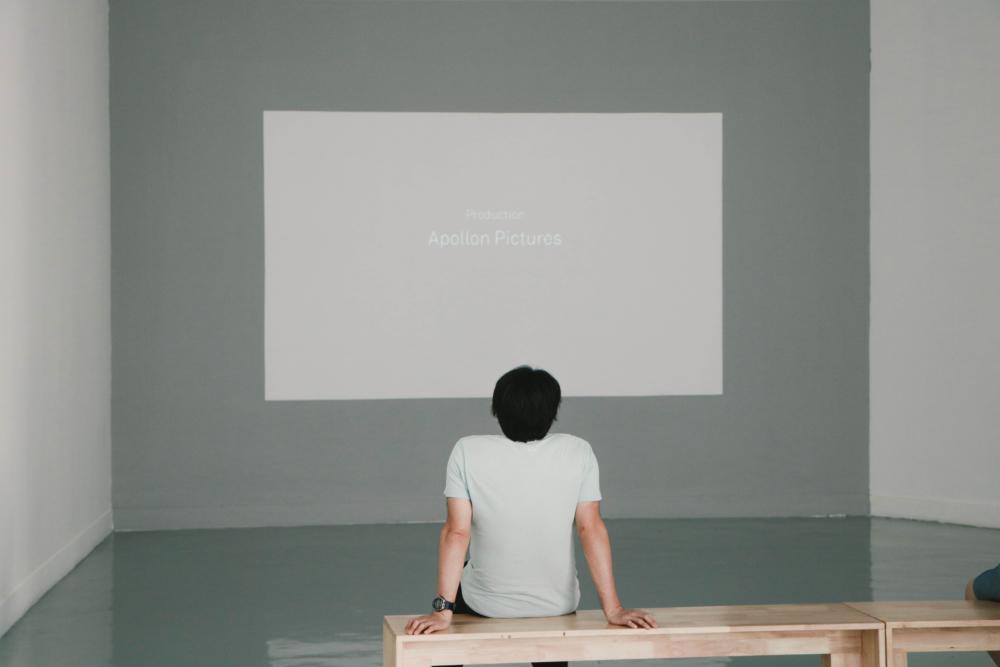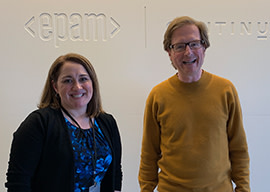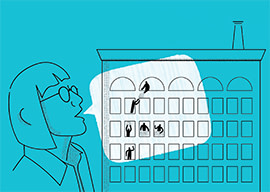
We project ourselves into the films we watch. A few—a very few—of these projections remain with us, as we go about the business of daily life. They can influence who we strive to be, and who we actually become. This is more serious than you might imagine. As famed director Jean-Luc Godard once said: “What is really at stake is one's image of oneself.” So, in the spirit of understanding employee experience, we thought it would be enlightening to ask our colleagues to trace which films have informed the person they are, when they come to work. The answers were diverse, interesting, honest, and fun. They say as much about our colleagues and our culture, as they do about the movies.
Clare Bond, Senior Director, Experience Design, EPAM
I’m thinking about Louise Banks, Amy Adams’ character in Arrival. Banks is a linguist, brought in to communicate with aliens (heptapods), whose egg-shaped spacecraft—the shell—hovers just above the earth's surface. She partners with physicist, Ian Donelly (Jeremy Renner), as part of a multidisciplinary team working to figure out the alien’s intent. Encased in a weird fog-filled vitrine, the heptapods communicate through ink blot-like circular shapes, extruded from their seven-limbed forms.
Banks’ journey of understanding is reminiscent of the ethnographic research process that is the core of our work as experience designers. Businesses have their own ecosystems, beliefs, values, and culture, plus a unique relationship with their customers. In the discovery phase of a project, we go in with beginner’s eyes and figure that ecosystem out. Where it works and doesn’t work, and how to bring those insights forward to transform and innovate, to create effective experiences, touchpoints, and interactions that empower.
As Banks enters the shell for the first time, clad in a cumbersome hazmat suit, traveling vertically in an inelegant scissor lift crane, the sound of her breathing indicates her mental state: hesitant, nervous, but determined. She’s well outside her comfort zone, in alien space. At the start of a project, the enormity of what you do not know can feel similarly overwhelming. What is at play here? Who are these people? How does this work? How does it all fit together?
After writing her name on a whiteboard and pointing to herself, she receives an inscrutable symbol in return. Banks abandons safety protocol, strips off her suit, and steps towards the vitrine, gently placing her hand inquisitively on the glass that divides her from the heptapods. Ethnographic research requires this kind of gesture: the empathetic understanding that emerges from stripping your protective suit of expectations and stepping into the unknown with open eyes and mind. It means walking in your participant's shoes and seeing through their eyes. It requires understanding their language, and patterns of engagement.
Embedded content: https://www.youtube.com/watch?v=E_AdXH59PEEBanks quickly realizes that the circular patterns they emit are their means of communication, and she collects different symbols as she strives to understand their intent. In a scene reminiscent of a research synthesis space, Banks and Donelly pin the alien symbols up in their workroom. They scan and analyze them for meaning, looking for the patterns that emerge from their exploration. As that meaning emerges, so Banks comes to understand their purpose and intent. Similarly, we look for patterns in the qualitative data we capture, looking for emerging themes, pain points and opportunities for transformation.
By uncovering their language, Banks comprehends their view of the universe, just as we map the cosmos of a business. She also understands their perception of time as non-linear, at once inhabiting past, present, and future, an act which ultimately transforms the world. As experience designers, our discovery also rests at the nexus of past, present, and future. We document the past, revealing the current state, before creating a future vision that impels companies forward. At the heart of the process is the deep discovery that provides a snapshot of the ecosystem in time and place, an understanding that transforms the future.
Banks’ fearlessness and commitment to her craft is something I aspire to, showing the role that ethnographic understanding can play in building connections and driving change.
Toby Bottorf, Senior Director, Head of Client Engagement, EPAM Continuum
Over the past nine years, I’ve led many service design projects that follow a regular, repeated sequence of activities. Learning leads to analysis and then to envisioning. And when we’re done, our service design vision turns into daily business operations. Operations is the “stuff” that service design is made of, the way industrial design is composed of material choices in metals, plastics, and firmware. Operations is our medium.
I’m fascinated by intensively operational businesses, the work where stuff comes at you fast and from surprising directions every day, where you do it, and come back again tomorrow and do it again, all at the same time trying to see and frame the bigger picture. I’m inspired here by the work of journalists. Like in the movie Spotlight (2015), which tracks an investigative team at my home-town paper, the Boston Globe.
Every newspaper reacts to the daily incoming noise and mayhem, while doggedly trying to make sense and find the big story. It’s not easy. The movie shows the Spotlight team doing the unflagging, unglamorous daily work of journalism—cross-checking volumes of directories line by line, knocking on doors that get slammed in their faces, tracking down documents at the courthouse. They wrestle with what their work means as the scope of the story takes shape.
Embedded content: https://www.youtube.com/watch?v=Zg5zSVxx9JMLike innovation, journalism is always work you do with incomplete information. The new editor of the Globe, Marty Baron, as played by Liev Schreiber, says: “Sometimes it's easy to forget that we spend most of our time stumbling around the dark.” And sometimes they break stories that change how we see the world. There is today, and another today, and another today, and if you can see through it, there is history.
I’m in a new role now. I lead our Client Engagement (or sales) team, which looks day-by-day to set up new relationships and projects for success, and aims, over a longer trajectory, to make sure that the work we do and the story we tell is aligned with future needs. I want to use each “today” and each call and conversation in service of that longer arc. I want to be inspired by the craft and vision of Marty Baron and the Spotlight team.
The movie makes very clear that Marty Baron is an outsider. Baron is not from Boston. He’s “an unmarried man from the Jewish faith who hates baseball.” He couldn’t be more different from Walter “Robby” Robinson—Michael Keaton's character—the leader of the Spotlight team, who went to high school right at BC High, across the street from the Globe’s offices on Morrisey Boulevard. I look for some inspiration to Marty’s judgment and vision as an outsider, because I’m doing a job I’ve never done before. Today. And again tomorrow. And again.
Stephanie Malliet, Director, People Experience, EPAM Continuum
CUT TO: A closeup on Jane Craig, from Broadcast News (1987).
Every morning before work, Craig—played by the brilliant Holly Hunter—unplugs her phone, grabs some tissues, and cries. She only does this for a few seconds, a quick emotional release, before going about her job as a highly functional network TV news producer. (I myself meditate before work but see the value in a good cry as well.) This does not come off as a weakness. Her strength is in her vulnerability and humanity.
Jane Craig is happiest when she’s controlling the chaos within a business that requires creativity and attention to detail, all while under high stakes deadlines. Although she is behind the scenes, she is an essential part of the process and success of the team. Not only is she fantastically good at her job, she is invested in the success of everyone she works with.
Embedded content: https://www.youtube.com/watch?v=YZ-yYcUmWSAHyper-connected to her co-workers, she shares a shorthand with her closest ally, Aaron Altman, played by Albert Brooks, that I also relate to: “I’ll meet you at the place near the thing where we went that time.” Creating trust with key colleagues not only creates meaningful relationships but is a special part of solidifying a shared culture and set of values.
After a tough day at work, I often turn to Broadcast News for inspiration. Jane doesn’t always give me answers, but she does give me comfort.
Jonathan Lupo, VP, Experience Design, EPAM
Lieutenant Vincent Hanna, a robbery-homicide detective played by Al Pacino in the 1996 Michael Mann film, Heat, is someone I both love and hate. He is not a true reflection of me, thankfully, and I think about his character as an exaggeration of some shared traits that have both positive and negative phenotypic expression.
Hanna is dangerous. He’s driven with purpose and his own beliefs. The commitment Hanna has to his internal code may suit him as a law-enforcement professional, but often cause his personal relationships to fall into ruin. His single-minded purpose makes him fearless, though, and enemies who think they have greater stamina and commitment soon realize that his is unmatched. He’s a force of nature.
As Hanna pursues the film's antagonist, master criminal Neil Macauley (Robert DeNiro), we see that these men are mirror reflections of each other, because they are both fueled by their passion, dedication to their craft, and committed to their warped ethical codes. Kindred spirits, they share a mutual respect (on display, as the two men share a coffee in a diner), but that respect soon turns into deadly caution, as each vow lethal commitment to an ending to the chase that would lead to the other’s downfall.
Embedded content: https://www.youtube.com/watch?v=0xbBLJ1WGwQIt may be audacious for me to relate the plight of the bigger-than-life screen detective to my personal and professional narrative… but Hanna and I share a strength that is also our greatest weakness. I refer to the dual nature of passion. It is both a blessing and a curse. Passion propels both of us. It drives our action and enables us to achieve goals by sheer force of will. Passion is a quality that I inherited from my dad. My dad inherited it from his dad. In fact, there are generations of Sicilian Lupo men that share this trait, genetically linked, and somehow represented in our name, “the wolves.” I don't know much about my ancestry, but there's something oddly coincidental in our family name's apt reflection of a defining characteristic of the men in the family. We all act with purpose and are bound by values, however, our actions are sometimes executed a bit too forcefully. And so... the dark side of passion is the force with which it is made manifest.
The force is what ruins Hanna’s personal life. Bound to his job (the police force), his duty, his nature, and driven by his passion, Hanna had no time for much else. He forcefully pursued his nemesis... with some high personal costs... like his daughter's mental health and his marriage.
Luckily, my professional passion hasn’t ruined my personal life. I keep Hanna’s story in mind as a cautionary tale. And age, as it turns out, it a natural force limiter. Therefore, I am looking forward to some golden years where my self-awareness and my age allow me to reap the benefits of passion, without the negative side effects.




